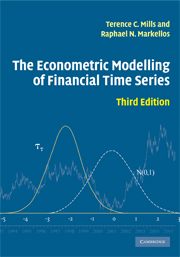Book contents
- Frontmatter
- Contents
- List of figures
- List of tables
- Preface to the third edition
- 1 Introduction
- 2 Univariate linear stochastic models: basic concepts
- 3 Univariate linear stochastic models: testing for unit roots and alternative trend specifications
- 4 Univariate linear stochastic models: further topics
- 5 Univariate non-linear stochastic models: martingales, random walks and modelling volatility
- 6 Univariate non-linear stochastic models: further models and testing procedures
- 7 Modelling return distributions
- 8 Regression techniques for non-integrated financial time series
- 9 Regression techniques for integrated financial time series
- 10 Further topics in the analysis of integrated financial time series
- Data appendix
- References
- Index
Preface to the third edition
Published online by Cambridge University Press: 05 June 2012
- Frontmatter
- Contents
- List of figures
- List of tables
- Preface to the third edition
- 1 Introduction
- 2 Univariate linear stochastic models: basic concepts
- 3 Univariate linear stochastic models: testing for unit roots and alternative trend specifications
- 4 Univariate linear stochastic models: further topics
- 5 Univariate non-linear stochastic models: martingales, random walks and modelling volatility
- 6 Univariate non-linear stochastic models: further models and testing procedures
- 7 Modelling return distributions
- 8 Regression techniques for non-integrated financial time series
- 9 Regression techniques for integrated financial time series
- 10 Further topics in the analysis of integrated financial time series
- Data appendix
- References
- Index
Summary
In the nine years since the manuscript for the second edition of The Econometric Modelling of Financial Time Series was completed there have continued to be many advances in time series econometrics, some of which have been in direct response to features found in the data coming from financial markets, while others have found ready application in financial fields. Incorporating these developments was too much for a single author, particularly one whose interests have diverged from financial econometrics quite significantly in the intervening years! Raphael Markellos has thus become joint author, and his interests and expertise in finance now permeate throughout this new edition, which has had to be lengthened somewhat to accommodate many new developments in the area.
Chapters 1 and 2 remain essentially the same as in the second edition, although examples have been updated. The material on unit roots and associated techniques has continued to expand, so much so that it now has an entire chapter, 3, devoted to it. The remaining material on univariate linear stochastic models now comprises chapter 4, with much more on fractionally differenced processes being included in response to developments in recent years. Evidence of non-linearity in financial time series has continued to accumulate, and stochastic variance models and the many extensions of the ARCH process continue to be very popular, along with the related area of modelling volatility. This material now forms chapter 5, with further non-linear models and tests of non-linearity providing the material for chapter 6.
- Type
- Chapter
- Information
- The Econometric Modelling of Financial Time Series , pp. xiii - xivPublisher: Cambridge University PressPrint publication year: 2008



